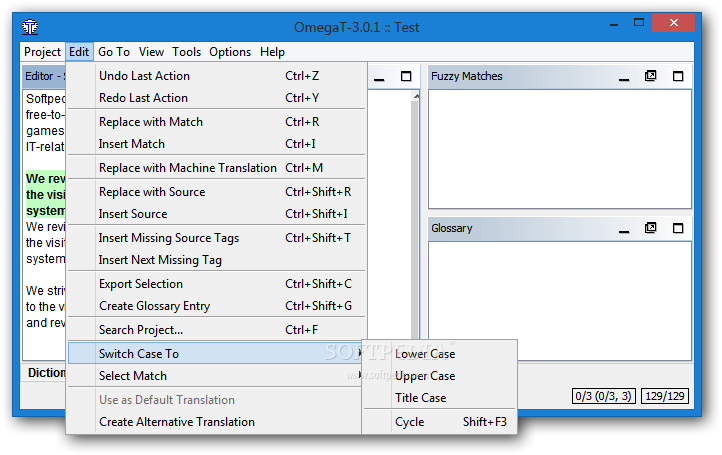

- OMEGAT MORE THAN 99 FILES HOW TO
- OMEGAT MORE THAN 99 FILES SOFTWARE
- OMEGAT MORE THAN 99 FILES CODE
- OMEGAT MORE THAN 99 FILES DOWNLOAD
OpenXML files are handled by the native filter OmegaT has both the native filters and the Okapi filters installed To be more specific, those ~$.(doc)x files are just temporary files that MSO creates when a file is open. It is related to the fact the MSO creates a temporary file when opening an OpenXML file, with a ~$ prefix and a standard ".x" extension, that OmegaT tries to unzip, and fails. > There is a bug in the handling of MSO files. py file and the executable binary in the same location.> On Nov 16, 2021, at 0:31, Jean-Christophe HELARY wrote:
OMEGAT MORE THAN 99 FILES CODE
The following code uses the Clustal Omega wrapper to develop MSA for the given input. fsa file used before, for this example as well. In my machine it was downloaded as clustal-omega-1.2.3-macosx. The name of the binary file may vary according to the binary file version you have downloaded. You can make it an executable using the command given below.
OMEGAT MORE THAN 99 FILES DOWNLOAD
To run the Clustal Omega wrapper, first you should download its precompiled binaries.
OMEGAT MORE THAN 99 FILES HOW TO
I will show how to use the Clustal Omega wrapper in the next example. You can check out all the wrappers and sample code from here. Clustal Omegaįigure 7: Results for the job on T-Coffee Biopython Wrappers for Clustal Omega and T-Coffeeīiopython, which I had introduced in my previous article, consists of command line wrappers for Clustal Omega, T-Coffee and many other tools such as ClustalW and DIALIGN. I will be using Clustal Omega and T-Coffee to show you a few examples of MSA. It is time to try out some tools and examples. The time you have been waiting for has arrived. This method divides the sequences into blocks and tries to identify blocks of un-gapped alignments shared by many sequences.ĭIALIGN2 is a popular block-base alignment approach.
OMEGAT MORE THAN 99 FILES SOFTWARE
The software package PRRN/PRRP is based on a hill-climbing algorithm to optimize its MSA alignment score. They work similarly to progressive methods, but repeatedly realign the initial sequences as well as add new sequences to the growing MSA. This method consists of a set of methods to produce MSAs while reducing the errors inherent in progressive methods. Two of the popular progressive alignment methods used at present are, It builds up a final MSA by combining pairwise alignments beginning with the most similar pair and progressing to the most distantly related pair. This method, also known as the hierarchical or tree method, was developed by Paulien Hogeweg and Ben Hesper in 1984. Hence they are considered as approximations but we can easily find a solution close to the actual one within a short time. These methods can find solutions among all possible solutions, but they do NOT guarantee that the best solution will be found. Given below are MSA techniques which use heuristic methods. Most MSA algorithms use dynamic programming and heuristic methods.

Hence computational algorithms are used to produce and analyze these alignments. Types of Multiple Sequence AlignmentĪligning three or more sequences can be difficult and are almost always time-consuming to align manually. The goal of MSA is to achieve the maximum Sum of Pairs. Sum of 2nd Col = score (K, R) + score (R, H) + score (K, H) = 2+0+-1 = 1 Example Sequence 1: G K N Sequence 2: T R N Sequence 3: S H E Sum of pairs: -1 + 1 + 6 = 6 Where score(A, B) = pair-wise alignment score of A, B. Score of multiple alignment = ∑ score(A, B) You can refer my previous article to learn about the different scoring matrices and how to match them.

The scoring process of MSA is based on the sum of the scores of all possible pairs of sequences in the multiple alignment according to some scoring matrix.


 0 kommentar(er)
0 kommentar(er)
